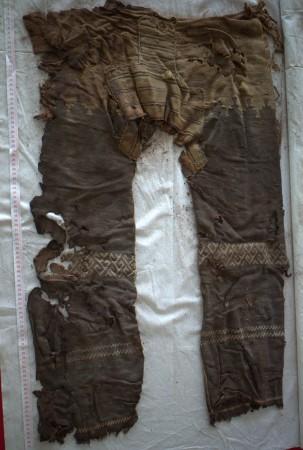
A pair of woolen trousers, which were recently discovered in a graveyard in western China, dates back to about 3,300 years, and archaeologists believe it is the world's oldest pants.
The discovery was made in the Yanghai graveyard in Tarim Basin. The research was conducted by a team, led by archaeologists Ulrike Beck and Mayke Wagner of the German Archaeological Institute in Berlin.
Trousers were made for horse riding in ancient days, and these pants are straight-fitted and have a wide crotch, resembling the modern day riding pants, according to Science News.
The discovery supports the previous work done by researchers that claims nomadics in Central Asia invented trousers, in order to provide protection to the body and allow freedom of movement for horseback riding.
"This new paper definitely supports the idea that trousers were invented for horse riding by mobile pastoralists, and that trousers were brought to the Tarim Basin by horse-riding peoples," said Victor Mair, linguist, University of Pennsylvania.
In Tarim Basin, the dry environment and hot summers helped in preserving human corpses, including clothing and other such organic material.
It was found that earlier Asians and Europeans wore gowns, tunics, togas and robes. Over 500 tombs have been unearthed in the graveyard since the early 1970s.
Previous researches, led by Mair, have hunted for mummies from different sites of Tarim Basin and identified a 2,600-year-old body named Cherchen Man, who was wearing burgundy trousers, possibly made of wool.
Trousers found from West Asia Scythian nomads dated close to 2,500 years. The researchers now suspect that horse riding began around 3,400 years ago, and the making of trousers came a little later.
The recently discovered trousers at Yanghai were from two men - 40 years old at the time of death - who may have been warriors and herders as well, explained the investigators.
One of the men had an ornamented leather bridle, a battle axe, a wooden horse bit and a leather bracer which provides arm protection. The other body lay with a whip, a bow sheath, a horse tail and a bow.
Radiocarbon dating was done on the fibres from both trousers by Beck and Wagner's group. The group obtained radiocarbon ages of fibers from both men's trousers, and of three other items in one of the tombs.
Rather than the modern day method of cutting down large fabric pieces, the early pants were woven in accurately sized segments, to form the finishing garment. Each pair of trousers was stitched by joining three pieces of brown-colored wool cloth. Each of the legs had one piece of cloth and the other for the crotch.
Beck and Wagner's group describes the prehistoric invention of trousers "a ground-breaking achievement in the history of cloth making".








